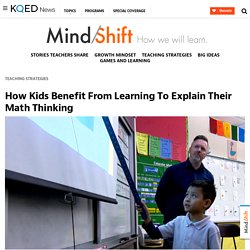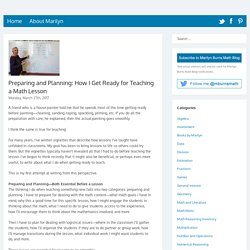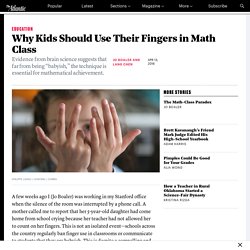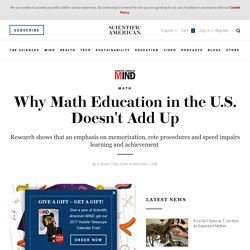

How to Improve Math Class. Related I love math, but I know that I’m unusual.

Math anxiety is a rampant problem across the country. Researchers now know that when people with math anxiety encounter numbers, a fear center in the brain lights up — the same fear center that lights up when people see snakes or spiders. Anxiety is not limited to low-achieving students. Many of the undergraduates I teach at Stanford University, some of the most successful students in the nation, are math traumatized.
The problem is the performance culture in our schools, more present in math than in any other subject. A few years ago I taught a summer math camp for sixth and seventh graders using open, creative, visual math tasks. What Would Happen If Students Assigned Their Own Math Homework? Is homework worthwhile?

Does doing it make a difference in learning? These questions are the source of much debate nowadays. Some may say homework is good practice, and practice makes perfect. Others insist homework is unproductive and pointless. What benefit is there in doing 20 of the same type of math problem? What if homework could be a means for promoting self-efficacy, agency, and motivation to learn?
In this light, the following option for math homework was born. How Kids Benefit From Learning To Explain Their Math Thinking. Math teachers of older students sometimes struggle to get students to explain their thinking with evidence.

It’s hard to get kids in the habit of talking about how they are thinking about a problem when they’ve had many years of instruction that focused on getting the “right answer.” That’s why educators are now trying to get students in the habit of explaining their thinking at a young age. The Teaching Channel captured kindergarten and first grade teachers pushing students to give evidence for their answers in situations where there are several ways to think about a problem.
Pattern recognition is a fundamental part of mathematics and kindergarteners are not too young to notice, compare and describe simple patterns. In this video, kindergarten teacher Donella Oleston describes how she had to back up and explain to these young learners what it means to “explain your thinking,” because at first students would only answer, “My brain told me so.” Katrina Schwartz. OPINION: It’s time to stop the clock on math anxiety. Here’s the latest research on how. Our future depends on mathematical thinking, but math trauma extends across our country – and the world – due to the ineffective ways the subject is often taught in classrooms, as a narrow set of procedures that students are expected to reproduce at high speed.

Preparing and Planning: How I Get Ready for Teaching a Math Lesson. A friend who is a house painter told me that he spends most of the time getting ready before painting―cleaning, sanding, taping, spackling, priming, etc.

If you do all the preparation with care, he explained, then the actual painting goes smoothly. I think the same is true for teaching. For many years, I’ve written vignettes that describe how lessons I’ve taught have unfolded in classrooms. My goal has been to bring lessons to life so others could try them. But the vignettes typically haven’t revealed all that I had to do before teaching the lesson.
Math Teachers Should Encourage Their Students to Count Using Their Fingers in Class - The Atlantic. Evidence from both behavioral and neuroscience studies shows that when people receive training on ways to perceive and represent their own fingers, they get better at doing so, which leads to higher mathematics achievement.

The tasks we have developed for use in schools and homes (see below) are based on the training programs researchers use to improve finger-perception quality. Researchers found that when 6-year-olds improved the quality of their finger representation, they improved in arithmetic knowledge, particularly skills such as counting and number ordering. In fact, the quality of the 6-year-old’s finger representation was a better predictor of future performance on math tests than their scores on tests of cognitive processing. Neuroscientists often debate why finger knowledge predicts math achievement, but they clearly agree on one thing: That knowledge is critical.
Nctm formative assessment part 1. WSJ A002 20161022. Why Math Education in the U.S. Doesn't Add Up. In December the Program for International Student Assessment (PISA) will announce the latest results from the tests it administers every three years to hundreds of thousands of 15-year-olds around the world.

In the last round, the U.S. posted average scores in reading and science but performed well below other developed nations in math, ranking 36 out of 65 countries. We do not expect this year's results to be much different. Our nation's scores have been consistently lackluster. Fortunately, though, the 2012 exam collected a unique set of data on how the world's students think about math. The insights from that study, combined with important new findings in brain science, reveal a clear strategy to help the U.S. catch up. The PISA 2012 assessment questioned not only students' knowledge of mathematics but also their approach to the subject, and their responses reflected three distinct learning styles.